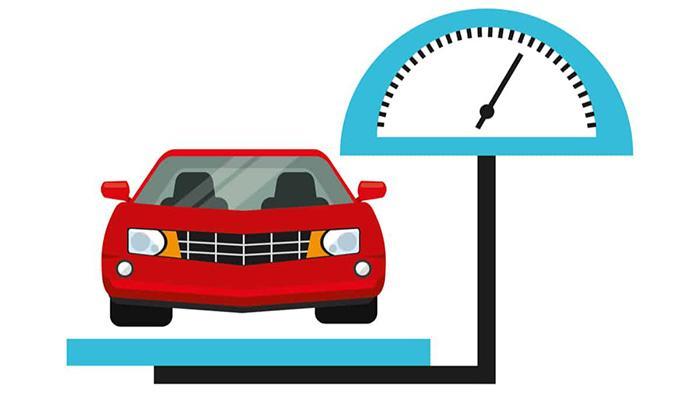700-2000 kgs
1,523 to 4,409 pounds
You Are Watching: How Much Does A Car Weigh Updated 04/2024
A car can weigh anywhere from about 700 kg to more than 2000 kg. The weight of a car depends on its model and manufacturer. How much a car weighs on average depends on what kind of car you think is average. No matter how you look at it, you need to know about how much a car weighs on average.
But most of a car’s weight comes from one part. So, a car with more space will weigh more than one with less space. Large, heavy cars, like full-size SUVs, are in this section. Some of them could weigh 2 tonnes or more. Because materials like carbon, fibre, aluminium, and magnesium are used to make them, supercars and hypercars that are lighter than 200 kilogrammes could weigh less than that.
Here are some examples of how the approximate weight of a typical car can be broken down into different groups:
It’s very important to know how much a car weighs for your own safety. The main purpose of a car is to move people from one place to another, which can only happen when someone is driving or watching it. So, knowing how a car or truck drives on the road compared to other vehicles, knowing how much it weighs is an important part of safety. It also helps figure out how much a car is worth.
Types of Vehicle Weight

The size of the engine and the parts used to make an automobile can make a big difference in how much it weighs. The type of car also makes a difference.
When it comes to vehicles, there are many different kinds of weights. But the Curb/Kerb weight and the Gross Vehicle Weight are the two most important and well-known car weights (GVW). You can usually find these terms on a car’s compliance plate and in the owner’s manual.
Curb Weight
Curb weight is also called “Kerb weight,” and it is the real weight of a vehicle with 90% of the fuel tank full, including all the equipment that came with it from the factory. Curb weight is how much a car weighs with all of its fluids and parts. It doesn’t include drivers, passengers, or cargo. In other words, it’s how much a car weighs when it’s sitting on a curb.
Gross Vehicle Weight (GVW)
Gross weight is the total weight of the car, which includes the curb weight, passengers, luggage, and any other items not made by the car’s maker.
Read More : Wheel Bearing Replacement Cost : Symptoms & How Much Updated 04/2024
If a car buyer only looks at the Curb weight or the Gross vehicle weight, they may not be able to figure out or analyse what the car will be used for. Even knowing how much a car or truck can carry is not enough.
Besides the curb weight and the gross vehicle weight (GVW), there are other types of weights, such as payload, gross vehicle weight rating (GVWR), gross combined weight, maximum loaded trailer weight, axle weight, and axle weight rating. These are the weights that consumers don’t pay much attention to, even though the manufacturer puts them out there.
It is important to understand what they mean because it can change how you feel about buying a car. The following weights of a car tell you what it can carry, how much weight it can hold, and where it can be driven.
Payload
The weight of everything being towed, including the driver, passengers, extra items, and anything else, is called the payload. It is the number of things that the vehicle can carry. To figure out how much a vehicle can carry, you need to know its gross vehicle weight rating (GVWR), which we’ll talk more about below, and its curb weight.
To find out how much a vehicle can carry, take the GVWR and subtract the curb weight.
For example, if a car has a GVWR of 1,688 kilogrammes and a curb weight of 1,262 kilogrammes, you can find the payload capacity by taking 1,262 kilogrammes away from 1,688 kilogrammes.
So, the answer is found by taking 1262 kg (the curb weight) away from 1688 kg (the GVWR). So, the maximum weight it can carry is 426 kilogrammes.
Gross Vehicle Weight Rating (GVWR)
GVWR is the manufacturer-set maximum weight limit. It looks at the vehicle’s base curb weight and adds the weight of any extra accessories, cargo, and passengers. This is the most a vehicle can weigh, including its passengers and its cargo. A vehicle should never be loaded more than the GVWR listed by the manufacturer.
Gross Combined Weight
It is a set weight that takes into account both the fully loaded weight of the tow vehicle and the weight of the trailer that is attached to it. This weight would include both the car and, if there is one, a trailer. Keep in mind that the gross combined weight should only be calculated when a trailer is attached to the vehicle.
Maximum Loaded Trailer Weight
The gross combined weight and the most the trailer can weigh when it’s full are very similar. The only difference is that it has to do with a fully loaded or maxed-out trailer.
Gross Axle Weight
The gross axle weight is the total amount of weight that a vehicle’s front and back axles support. An axle is the centre shaft of a gear or a wheel that turns on a car.
Gross Axle Weight Rating
Gross axle weight rating is the maximum amount of weight that can be put on each axle and is set by the manufacturer. This number should not be exceeded. So, in simple terms, GAWR is the weight limit for each axle (front and back) of the vehicle, which is set by the automaker.
Read More : Top 5 Car Brands That You Need Know Updated 04/2024
The main reason why automakers set limits on how much weight a vehicle’s axles can carry is for safety. Safety in cars is a top priority. Adding extra weight to a vehicle is very dangerous, especially if the axles are overloaded and the weight is not distributed evenly.
When it comes to safety and precautions, the weight of a car is one of the most important things to think about when buying or looking for a car. When a car’s weight goes over what the manufacturer says it can hold, there are many risks. When a vehicle is overloaded, it can cause problems with many of its parts. For example, because of the extra weight, the steering wheel may become less responsive. So the way the car handles as a whole will change in a big way.
A car’s brakes might not work right or be strong enough to slow down a vehicle by a lot. Because of the extra weight, the tyres may get too hot, which could lead to a blowout, which is dangerous. It can also cause mechanical failure, because overloading and overstressing parts in a car can lead to accidents because the driver can’t control the car.
Keep in mind that none of these should ever weigh more than what the manufacturer says is safe.
How to find the weight of a certain vehicle?

With social media and the internet, it’s not hard to find out how much a certain vehicle weighs. Also, there are a lot of websites that are just about cars, so it would be easy to get the information from them. Some places where you can find out how much a car weighs are:
1. Manufacturer
One can call the customer service number listed in the manual and tell them about the car to find out what they need.
2. Driver’s side door sill or jamb
It’s easy to find the label that says how much a car weighs. Open the door on the driver’s side of the car and look for a sticker on the sill that says the car’s weight.
3. Car manual
This is an easy choice. One can look at the car’s manual to find out about its specs.
4. Vehicle scale
If none of these options work, you could always put the car on a vehicle scale and weigh it that way.
Conclusion
When it comes to a car’s weight, there is one more important thing to remember. It is the most a car can weigh on a road. The weight of a car that can travel on highways and through different states in a country is set by each state. It’s important to know what your state or country’s weight limits are. If you are worried, you should look at or ask about a weight chart for the state or province you are going to. This way, all the trouble and problems that don’t need to happen won’t.
If you liked this article, be sure to read: Can you push-start an automatic car? and Can you drive with a blown head gasket?
Sources: https://micdot.com
Category: Car










